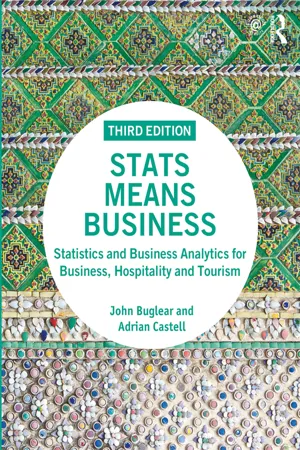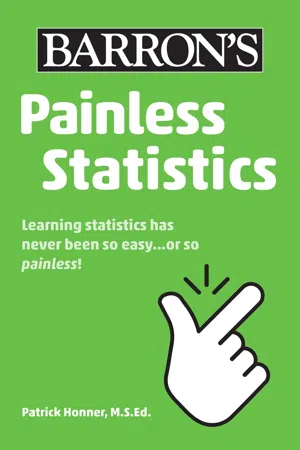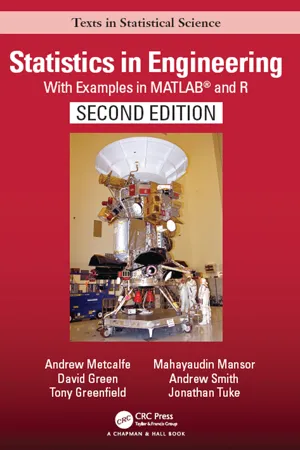Mathematics
Continuous and Discrete Data
Continuous data can take on any value within a given range and can be measured. It includes values such as height, weight, and temperature. Discrete data, on the other hand, consists of distinct, separate values and is typically counted. Examples include the number of students in a class or the number of cars in a parking lot.
Written by Perlego with AI-assistance
Related key terms
Related key terms
1 of 4
Related key terms
1 of 3
6 Key excerpts on "Continuous and Discrete Data"
- eBook - ePub
Stats Means Business
Statistics and Business Analytics for Business, Hospitality and Tourism
- John Buglear(Author)
- 2019(Publication Date)
- Routledge(Publisher)
continuous. This is what you are doing when you give your age to the last full year. Similarly, the temperatures in weather reports are rounded to the nearest degree, and distances on road signs are generally rounded to the nearest mile or kilometre. Such data are discrete by convention rather than by definition.Discrete data often but not always consist of whole number values. The number of visitors to a website will always be a whole number, but UK shoe sizes include half sizes. In other cases, like the UK sizes of women’s clothing, only some whole numbers occur.The important thing to remember about discrete data is that there are gaps between the values that can occur, which is why they are sometimes described as discontinuous data. In contrast, continuous data consist of numerical values that are not restricted to specific numbers. Such data are called continuous because there are no gaps between feasible values. This is because measuring on a continuous scale, such as distance or temperature, yields continuous data.The precision of continuous data is limited only by how exactly the quantities are measured. For instance, we measure both the length of bus journeys and athletic performances using the scale of time. For bus journeys a clock or a wristwatch is sufficiently accurate, but for athletic performances we would use a stopwatch or an even more sophisticated timing device.Later we will use the terms discrete variable and continuous variable - eBook - ePub
- Stephen A. Thompson(Author)
- 2017(Publication Date)
- CRC Press(Publisher)
−1 ) = 3154.68 cm. The original measurement was precise to the nearest 0.1 ft, whereas the converted distance now appears to a precision of 0.01 cm. Since we multiplied the two numbers, relative precision governs the result. The final answer cannot exceed the least-relatively-precise number in the multiplication. We should therefore round the converted distance to four significant figures, or 3155 cm. Dingman (1984) recommends that unless greater precision is warranted, assume no more than three significant figures for hydrologic measurement and analysis.2.3 Continuous and Discrete DataData type can refer to various characteristics of environmental data. One characteristic introduced in Chapter 1 was of the data being either continuous or discrete. Another data characteristic is the level of measurement. First we explore the continuous versus discrete issue in more detail. The issue of continuous versus discrete data was raised with reference to the time variable in Equation (1.1) . Continuous means there are an infinite number of data values. Discrete means there are a finite number of data values. Time is a continuous variable because time flows seamlessly from one moment to the next. An analog clock with a sweeping second hand shows time changing continuously. Length is also a continuous variable because a given length can be subdivided into an infinite number of smaller intervals. However, the number of trees on your college campus, or the number of rainy days in a year are discrete phenomena. Continuous time displayed on a digital clock has been ‘discretized’ into discrete intervals.For practical purposes, continuous data are often made discrete through either the measurement process, or to simplify an analysis. Methods of measurement create two types of discretized hydrologic data: sample data and pulse data (Chow et al. 1988). A continuous process sampled at discrete points in time creates a sample data series. Sample data represent the instantaneous value of the variable measured at that moment. In Figure 2.1a we have a record of continuous data as a function of time. These data could be streamflow, air temperature, water level in a reservoir or any continuous process. In Figure 2.1b , sampling at discrete intervals produces a set of sample data. The magnitude of the sample data point equals is the value of the continuous process at that instant. The dimensions of sample data are the same as the dimensions of the original continuous data. Pulse data are created by accumulating the continuous data over some time interval. The total accumulated value over the interval is the pulse data value. Accumulating the continuous process from time t1 to t2 in Figure 2.1c represents the pulse data value for that time period. Precipitation data are pulse data and are recorded as the accumulated depth of water over an interval of time. The dimensions of pulse data are different from the original continuous data. Precipitation pulse data have the dimension length (L), whereas the original continuous data were (LT−1 - eBook - ePub
- Patrick Honner(Author)
- 2022(Publication Date)
- Barrons Educational Services(Publisher)
4.Phoenix, Arizona, has a population of 1.7 million people and a police budget of $0.909 billion. Plot this point in the appropriate location on the following scatterplot of police budget vs. population.Police Budget vs. Population(Answers are on pages 41–42 .)Discrete Data vs. Continuous DataThe majority of examples of quantitative data so far have been examples of discrete data. Discrete data is data that can only take certain values. For example, the variable “number of siblings” can only take whole number values, like 0, 1, 2, 3, etc. You can’t have 2.7 siblings. The number of courses you are enrolled in, the number of states a company does business in, and the number of different stocks owned are all examples of discrete variables.Continuous data is data that can take any value between whole numbers. How long a patient waits for a hospital bed, the circumference of your skull, or the amount of iron in your blood are all examples of continuous variables. This kind of quantitative data is not restricted to taking whole number values.Sometimes it is convenient to round continuous data. In Chapter 1 , all the commute times were given as whole numbers, even though theoretically a commute could be 28.65 minutes or 31.174 minutes long. In this case, not much information was lost by rounding to the nearest whole number, and the data was easier to work with as a result. Similarly, the age data from earlier in this chapter was rounded. No one was considered 13.5 years old. However, it can also be useful to work with continuous data that can take all possible values, as shown in the following example.Example 7:Suppose you wanted to analyze customer service at your company. One quantitative variable you could look at is how long a customer has to wait on hold before speaking to a representative. This is continuous data. A customer could wait 1.2 minutes, 1.5 minutes, or 2.7 minutes.You could display this continuous data using a frequency histogram. Here’s an example using bins of size 1, showing the amount of time callers wait to speak to a customer service representative. - eBook - ePub
Statistical Analysis in Forensic Science
Evidential Value of Multivariate Physicochemical Data
- Grzegorz Zadora, Agnieszka Martyna, Daniel Ramos, Colin Aitken(Authors)
- 2013(Publication Date)
- Wiley(Publisher)
3 Continuous data 3.1 IntroductionThis chapter presents some general background information on continuous data that is necessary to fully understand the topics on which the book focuses in other chapters (see also Aitken and Taroni 2004; Curran 2011; Lucy 2005). Examinations performed by the application of various analytical methods (Chapter 1) return various kinds of information:- qualitative data, for example, information on compounds detected in fire debris samples based on a chromatogram, information obtained from the spectrum of an unknown sample, and morphological information such as the number and thicknesses of layers in a cross-section of car paints;
- quantitative data, for example, the concentration of elements or value of the refractive index in a glass fragment, peak areas of a drug profile chromatogram or gasoline detected in fire debris, and the concentration of ethanol in blood samples.
Another way to classify data is connected with the possible values they may generate. If the analysis produces data that can take any value within a specified range, they are considered to be continuous , as opposed to discrete data, which may take certain values. A Typical examples of continuous data are human height and the elemental composition of glass fragments. A typical example of discrete data is the number of children in a family, as it may take only integer values, and cannot take values such as 3.3. Most of the data that chemists have to deal with are of continuous type and so this book focuses on them.Physicochemical data analysis requires some data organisation. A recommended way to do so is to present the data generated during the analysis in the form of a rectangular table as in Figure 3.1 (see also the example of a database in the file glass_data.txt ).1 Such tables containing data may take the form of what is generally called a matrix, as in Figure 3.2(a) .Figure 3.1 Data organisation in the form of a matrix. Here the data refer to p variables (X p ) measured three times for each of m - eBook - ePub
Building Proofs
A Practical Guide
- Suely Oliveira, David Stewart(Authors)
- 2015(Publication Date)
- WSPC(Publisher)
Chapter 3Discrete and continuous
It is easy to divide mathematics into “discrete mathematics” and “continuous mathematics”: discrete mathematics is about whole numbers and discrete objects, continuous mathematics is about real numbers and approximations. Continuous mathematics is about limits, while discrete mathematics is about counting and algebra. Proofs about limits or continuity usually involve statements like “For every > 0 there is . . .” In fact, the two are intertwined, and one is often used to help the other. Asymptotic results about discrete objects require continuous mathematics: the number of primes ≤ x divided by x /ln x goes to one as x → ∞ . And continuous functions have discrete properties: A continuously differentiable function where f (x ) = 0 implies f ′(x ) ≠ 0, and f (a ) f (b ) < 0, has an odd number of zeros in [a , b ].In this chapter we investigate a number of topics taken from both continuous and discrete mathematics. Some ideas (“calculate the same thing in two different ways”, “swapping the order of summation”, and “emphasizing the important”) are equally applicable to discrete and continuous mathematics. Some ideas (“prime numbers”, “divisibility”, and “graphs and networks”) are especially appropriate for discrete mathematics, while others (“convergence”, and “least upper bound property”) are especially appropriate for continuous mathematics.3.1Inequalities
Inequalities are essential in any understanding of approximations and real numbers. But there is something tactically different about proving inequalities than proving equalities. Every equality is reversible: “a = b ” means “b = a ”. But this is not so for inequalities. If, in the middle of a proof of “a ≥ b ” we have managed to show “a ≥ c ” where b > c - eBook - ePub
Statistics in Engineering
With Examples in MATLAB® and R, Second Edition
- Andrew Metcalfe, David Green, Tony Greenfield, Mayhayaudin Mansor, Andrew Smith, Jonathan Tuke(Authors)
- 2019(Publication Date)
- Chapman and Hall/CRC(Publisher)
3 Graphical displays of data and descriptive statisticsWe consider how to take a sample so that it is likely to be a fair representation of the population from which it is drawn. You will learn how to present data using diagrams and numerical summary measures. In some applications the time order of the observations is particularly relevant, and we refer to the data as a time series. We consider a descriptive approach that describes a time series as a combination of a trend, seasonal effects and an random component.3.1 Types of variablesConsider a set of items, and define a variable as a feature of an item which can differ from one item to the next. Variables that are measured on a numerical scale can conveniently be classified as discrete or continuous. Discrete variables are usually a count of the number of occurrences of some event and are therefore non-negative integers {0, 1, 2, …}. Continuous variables such as mass, temperature and pressure are measured on some underlying continuous scale.Other variables provide a verbal rather than a numerical description, and are referred to as categorical variables. If the categories of a categorical variable can be placed in some relevant order it is referred to as an ordinal variable.We illustrate the use of these terms in the following six examples. Example 3.1: Integrated circuit chips [discrete variable]A typical very-large-scale integrated circuit chip has thousands of contact windows, which are holes of 3.5 microns diameter etched through an oxide layer by photolithography. A window is defective (closed) if the hole does not pass through the oxide layer. A factory produces wafers that contain 400 chips, arranged in four sectors that are referred to as north, east, south and west. There is a test pattern of 20 holes systematically located within each sector. A robot records the number of closed windows in each test pattern. The number of closed windows is a discrete variable that can take any integer value between 0 and 20. A sector is scrapped if any closed windows are found in the test pattern.
Index pages curate the most relevant extracts from our library of academic textbooks. They’ve been created using an in-house natural language model (NLM), each adding context and meaning to key research topics.
Explore more topic indexes
Explore more topic indexes
1 of 6
Explore more topic indexes
1 of 4





